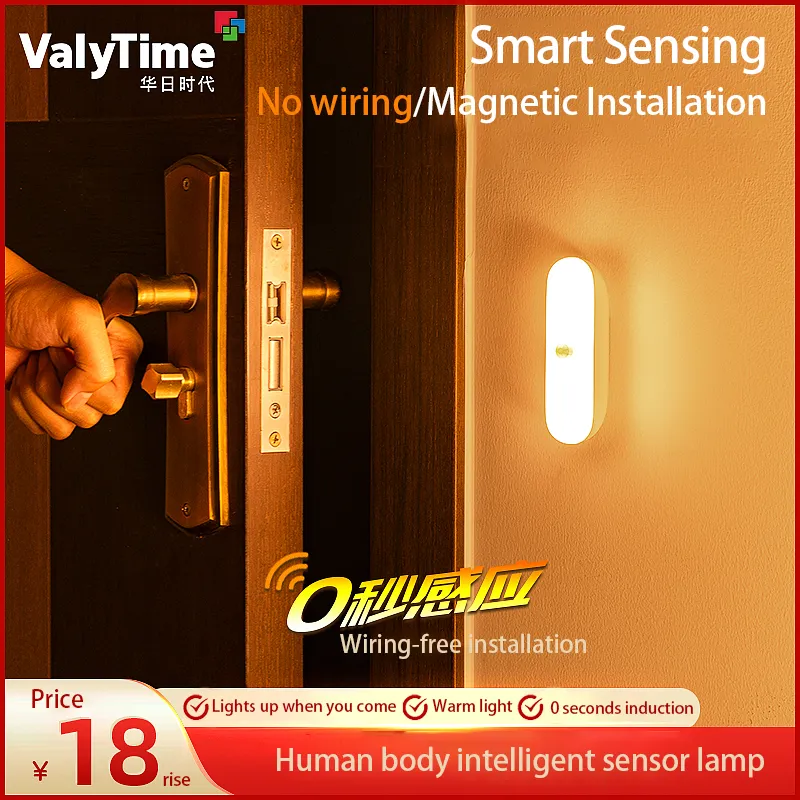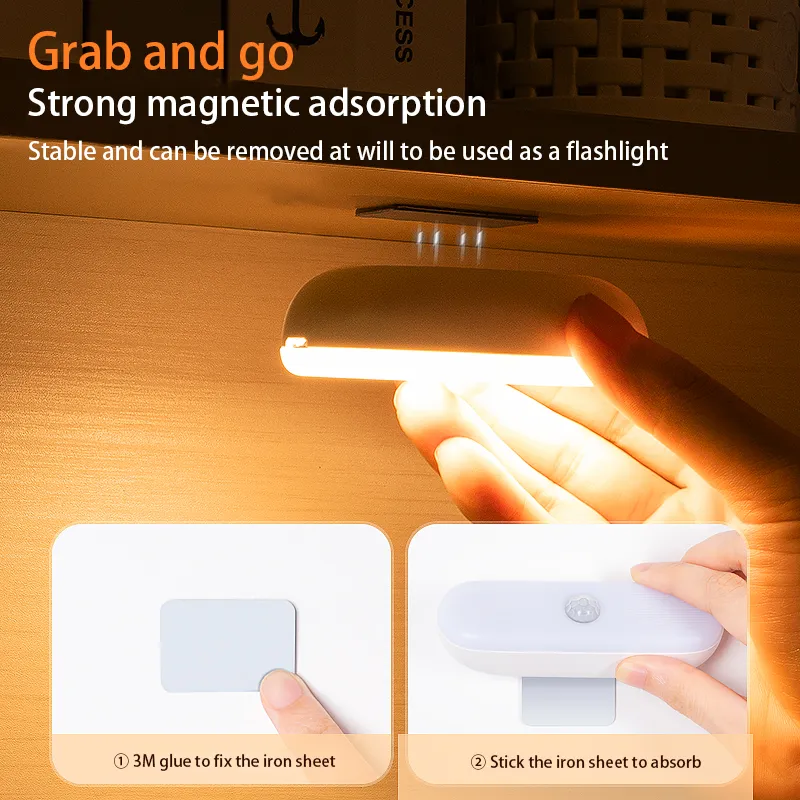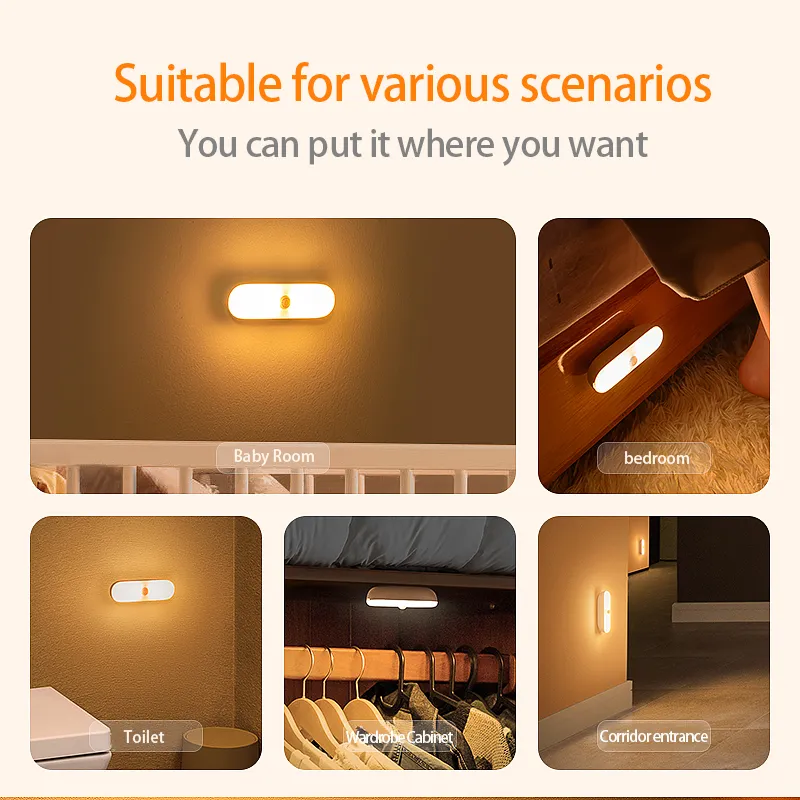Why Do Motion Sensor Nightlights Indoors Fail?
In today's widespread use of smart lighting products, motion sensor nightlights indoors have become indispensable lighting devices in many homes. They automatically sense human activity at night, turning on and off when no one is around, offering both energy efficiency and convenience. However, many users find that after a period of use, the nightlight suddenly stops working, becomes sluggish, experiences frequent accidental touches, or even malfunctions completely.
This leads to the question: Why do motion sensor nightlights indoors fail?
This seemingly simple question involves multiple technical aspects, including the power supply system, sensor module, photosensitive circuitry, and environmental interference.
This article will provide a professional perspective, deeply analyzing the core reasons for motion sensor nightlight indoor failures and offering scientific and effective troubleshooting methods.

What is the working principle of a motion sensor nightlight indoor?
Before discussing failures, we need to understand how a motion sensor nightlight indoor works.
Typically, it consists of three core parts:
1). LED Light Source Module
Provides lighting functionality, with a power consumption typically between 0.2W and 2W, featuring high energy efficiency and a long lifespan.
2). PIR Infrared Motion Sensor
This is a passive infrared sensor that detects changes in infrared radiation emitted by the human body to determine if someone is approaching.
3). Control Circuit and Photosensitive Sensor
The control module determines whether to turn on the LED light based on ambient light intensity and sensor signals, thus achieving the function of "automatically turning on at night and off during the day."
When someone passes by, the thermal radiation signal emitted by the human body is captured by the infrared sensor. The control circuit quickly detects this and turns on the light; after a delay (e.g., 30 seconds or 1 minute) after no activity is detected, the light automatically turns off.
Therefore, if any part of this component malfunctions, the entire system's sensing function may "fail."

Why does the motion sensor night light indoor suddenly go out?
If your motion sensor night light indoor suddenly goes completely out, it is usually caused by the following reasons:
1. Power Supply Problem
Power supply is the most common source of failure. Whether battery-powered or plug-in, if the power supply cannot provide sufficient voltage, the system will not function properly.
Possible causes include:
• Depleted battery or poor contact;
• Loose plug or damaged power cord;
• Aging internal circuitry causing current interruption.
In this case, the night light cannot receive power and therefore cannot light up or sense anything.
2. Damaged LED Chips
Although LEDs have a long lifespan, prolonged overheating or unstable voltage can cause the LED chips to burn out. When the LED itself is damaged, the light will not light up even if the sensor is still working.
3. Circuit Board Failure
The main control circuit board is the brain of the motion sensor night light indoor. If capacitors, transistors, or microcontroller chips are damaged, the system signal cannot be transmitted correctly, and the sensing or lighting function will fail.
4. Failure of the Photosensitive Component
If the night light has a light-controlled function (i.e., it doesn't light up during the day and automatically lights up at night), a damaged or misjudged photosensitive sensor will prevent the entire light from starting at night.
For example, when the photoresistor is blocked by dust or detects too much ambient light, it will "think" that daytime still exists and thus refuse to light up.

Why is the motion sensor in the night light indoor not sensitive?
Sometimes the light isn't completely off, but rather its sensitivity is reduced, or it works intermittently. The main reasons for this include:
1. Contaminated Sensor Surface
Infrared sensors require a clear lens surface to capture infrared signals. If the surface is covered with dust, oil, moisture, or cobwebs, it will significantly weaken the sensing ability.
2. Ambient Temperature Interference
PIR sensors identify moving targets by detecting temperature differences. When the ambient temperature is close to human body temperature (approximately 32°C–37°C), the temperature difference decreases, leading to a decline in sensing ability.
Therefore, nightlights often malfunction in hot summer weather.
3. Inappropriate Sensing Angle or Distance
The sensing range of an indoor motion sensor nightlight is typically 120° angle and a distance of 3–6 meters. If the installation position is too high, too low, or away from the direction of activity, the sensor may not be able to accurately detect human movement.
4. Insufficient Battery Voltage
For battery-powered nightlights, when the voltage is below the sensor module's operating threshold (typically 2.8–3V), the sensor module may experience delays or misjudgments, resulting in intermittent illumination.
Why does the motion sensor nightlight indoor frequently trigger false triggers?
Another type of problem, opposite to "insensitive sensing," is frequent light activation, i.e., "false triggering." While not a failure, this significantly shortens battery life.
Causes of this include:
1). Environmental Interference Signals
Infrared sensors can detect not only human body heat but also interference from hot air, sunlight reflection, heating systems, pets, etc. For example, air conditioner vents or heat sources can create infrared changes, misinterpreting them as people passing by.
2). Inaccurate Photoresistor
If the photoresistor perceives the environment as too dark, it may trigger the light even during the day, causing excessively frequent activation.
3). Improper Installation Location
Installing the motion sensor nightlight indoor near doorways, windows, or air ducts makes it susceptible to external temperature fluctuations, leading to false triggering.
Why does my motion sensor nightlight indoor exhibit delayed or flickering illumination?
Delayed illumination or brightness fluctuations typically stem from the following technical issues:
1. Unstable Power Output
Insufficient power supply or voltage fluctuations cause discontinuous sensor signal processing, resulting in delayed activation or flickering light.
2. Aging Delay Circuit
Nightlights usually contain a delay control capacitor to keep the light on for a period of time. With age, the capacitor's capacitance decreases, leading to shorter or unstable delays.
3. Slow Sensor Module Response
Prolonged exposure to high temperatures or humidity can affect the sensitivity of the PIR module, causing signal transmission delays.
4. Photosensitive Circuit Flickering
In environments with frequently changing light (such as near a window or flickering lights), the photosensitive circuit frequently switches between "on/off" modes, causing the nightlight to flicker.

Why does my motion sensor nightlight indoor completely fail?
If your motion sensor nightlight indoor completely fails to respond to any signal, it can be considered "failed." This failure may be caused by the following root causes:
1. Power supply interruption
This is the most common root cause.
When the battery compartment contacts are loose, solder joints fall off, power cords break, or the voltage is too low, the entire system is in a power-off state, and neither the sensor nor the LED light will work.
2. Damaged main control chip
The main control chip is a key component that coordinates the sensor input and LED output. If the chip burns out due to overcurrent, static electricity, or moisture, the device will completely stop responding.
3. Moisture or oxidation of the circuit board
A humid environment can easily cause oxidation of the metal parts of the circuit board, leading to leakage or short circuits, thus causing the night light to fail. This problem is especially common for night lights installed in high-humidity areas such as bathrooms and kitchens.
4. Conflict between photosensitive and PIR dual signals
Some dual-sensor designs (photosensitive + infrared) may experience a logic deadlock when the circuit malfunctions: the photosensitive signal continuously interprets it as "daytime," preventing the infrared module from starting, thus causing the light to remain off for an extended period.
Can a motion sensor night light indoor be repaired?
From a technical perspective, motion sensor nightlight indoors is a low-power electronic product with a relatively simple structure. Theoretically, most problems can be repaired once the fault point is identified.
However, for ordinary users, the following points are more practical:
• Check for oxidation at the power supply and battery contacts: Clean the electrodes with a cotton swab dipped in a small amount of alcohol.
• Reset the light: Unplug the power or remove the battery for a few minutes to allow the circuit to reinitialize.
• Wipe the sensor lens: Clean it with a clean, soft cloth to ensure proper infrared sensing.
• Avoid high-temperature or humid environments: Especially in areas such as bathrooms, kitchens, and balconies, choose nightlights with waterproof and moisture-proof designs.
If the above steps do not restore functionality, it indicates that the internal circuitry or main chip is damaged. In this case, replacing the light is more economical.
How to prevent motion sensor nightlight indoors from malfunctioning?
Prevention is always better than repair. To extend the lifespan of the motion sensor nightlight indoors, pay attention to the following during daily use:
1. Clean the sensor regularly
Wipe the lens with a dry cloth every 1–2 months to prevent dust accumulation from affecting sensing sensitivity.
2. Avoid direct sunlight and strong heat sources
Strong light and heat sources can interfere with infrared recognition and even damage the internal components of the sensor.
3. Proper installation height and orientation
The ideal installation height is 1.8–2.5 meters, and the sensor should be directly facing the main direction of human movement.
4. Use a stable power supply
Avoid using inferior batteries or sockets to prevent voltage fluctuations from damaging the circuitry.
5. Keep dry and well-ventilated
Especially in humid environments, choose models with waterproof ratings (such as IP44 or IP65).
Good usage and maintenance habits can significantly slow down the aging and failure process of the motion sensor nightlight indoor.
What are the signs of motion sensor nightlight indoor failure?
Before complete failure, the nightlight usually exhibits some warning signs that are worth noting:
1. Shortened illumination time
The light, which originally had a 1-minute delay, suddenly only illuminates for a few seconds before turning off.
2. Reduced sensing distance
You need to be very close to the light to be triggered.
3. Intermittent Operation
Sometimes it lights up, sometimes it doesn't respond at all.
4. Continuously On
Lost the automatic shut-off function and remains constantly on.
5. Flashing or Delayed Start-up
The light flashes several times or the start-up time becomes longer with each trigger.
These phenomena often indicate sensor aging, capacitor depletion, or insufficient power supply voltage, and should be investigated promptly.
What are Huari’s advantages compared to other LED factories in China?
Experience, scale, and quality control set us apart. Since 1996, Huari Lighting has focused exclusively on LED manufacturing. Our 92,000 m² site integrates production, assembly, and testing facilities, allowing full control from materials to final shipment. Unlike trading companies, we are a real factory, enabling better prices, flexible lead times, and OEM customization.
